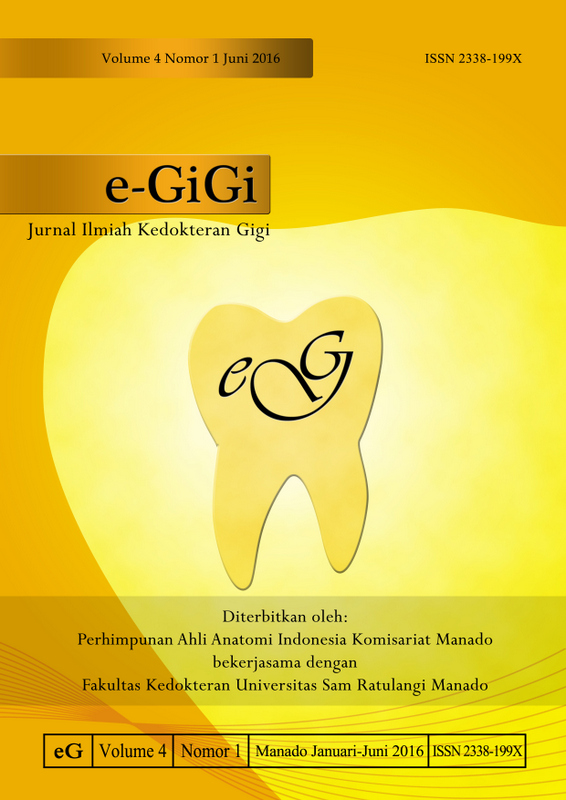Pengaruh konsumsi semangka (Citrullus lanatus) dalam menurunkan indeks debris pada anak usia 8-10 tahun
DOI:
https://doi.org/10.35790/eg.4.1.2016.11484Abstract
Abstract: Fresh fruit consumption which is rich in vitamins, minerals, fibers, and water can expedite tooth self cleansing, therefore, debris width surface can be decrease. Watermelon is one of favorable fruits with sweet taste. Watermelon contains 91.45 g water and 0.4 g fiber every 100 g of watermelon flesh. Debris affects the occurrence of caries. According to Basic Health Research (RISKESDAS) in 2013, dental and oral health problems, specifically in North Sulawesi, were 31.6%; caries in North Sulawesi was 5.4%. Preventive efforts towards caries among children must be done systematically and as early as possible. Age category 8th – 10th is the most critical on the occurrence of caries. This study aimed to find out whether watermelon consumption can decrease debris index among children aged 8-10 years old. This was an experimental study with a pre-experimental design one-shot case study and a pre-test and post-test approach. This study was conducted at SDN 118 Manado, with a total population of 38 students. Samples were obtained by using the total sampling method. Based on the Wilcoxon test, the significance probability value was p = 0.000 which meant that there was a significant difference between debris index before and after watermelon consumption. Conclusion: Watermelon consumption can decrease debris index among children aged 8-10 years.
Keywords: watermelon, debris index, children
Abstrak: Konsumsi buah yang segar dan kaya akan vitamin, mineral, serat dan air dapat melancarkan pembersihan sendiri pada gigi, sehingga luas permukaan debris dapat dikurangi. Semangka merupakan buah yang banyak disukai karena rasanya yang manis. Dalam semangka terkandung kadar air yang cukup tinggi yaitu 91,45 g dan kadar serat sebesar 0,4 gr tiap 100 g daging buah semangka. Debris berpengaruh cukup besar terhadap proses terjadinya karies. Berdasarkan Riset Kesehatan Dasar (RISKESDAS) pada tahun 2013, masalah gigi dan mulut khususnya di Provinsi Sulawesi Utara sebesar 31,6%, dan yang mengalami karies gigi sebesar 5,4%. Upaya preventif pada anak diperlukan untuk mengatasi karies gigi serta dilakukan secara sistematis dan sedini mungkin. Usia 8-10 tahun merupakan kelompok usia yang kritis terhadap terjadinya karies gigi. Penelitian ini bertujuan untuk mengetahui pengaruh mengonsumsi semangka dalam menurunkan indeks debris pada anak usia 8-10 tahun. Penelitian ini menggunakan metode eksperimental dengan rancangan pra-eksperimental jenis one-shot case study dan pendekatan pre dan post-test perlakuan. Penelitian ini dilaksanakan di SDN 118 Manado dengan populasi sebanyak 38 siswa. Sampel penelitian ini didapatkan dengan teknik total sampling. Berdasarkan uji Wilcoxon nilai probabilitas signifikansi p = 0,000 yang artinya terdapat perbedaan bermakna antara selisih indeks debris sebelum konsumsi semangka dan setelah konsumsi semangka. Simpulan: Konsumsi semangka dapat menurunkan indeks debris pada anak usia 8-10 tahun.
Kata kunci: buah semangka, indeks debris
Downloads
How to Cite
Issue
Section
License
COPYRIGHT
Authors who publish with this journal agree to the following terms:
Authors hold their copyright and grant this journal the privilege of first publication, with the work simultaneously licensed under a Creative Commons Attribution License that permits others to impart the work with an acknowledgment of the work's origin and initial publication by this journal.
Authors can enter into separate or additional contractual arrangements for the non-exclusive distribution of the journal's published version of the work (for example, post it to an institutional repository or publish it in a book), with an acknowledgment of its underlying publication in this journal.
Authors are permitted and encouraged to post their work online (for example, in institutional repositories or on their website) as it can lead to productive exchanges, as well as earlier and greater citation of the published work (See The Effect of Open Access).






